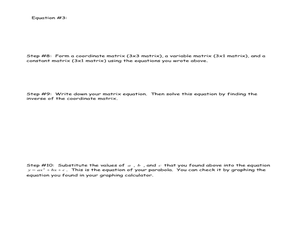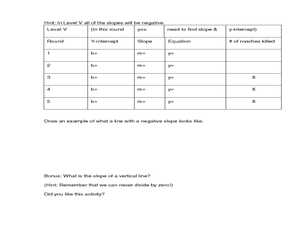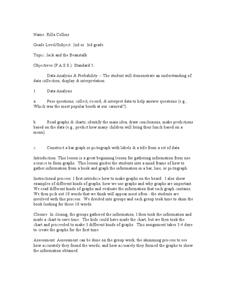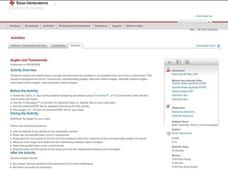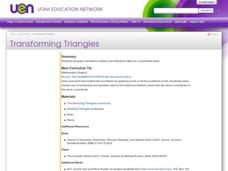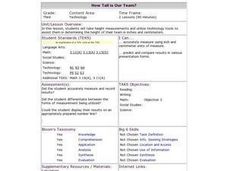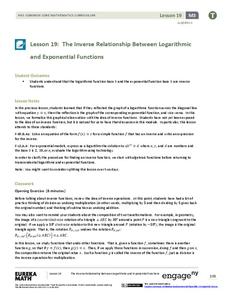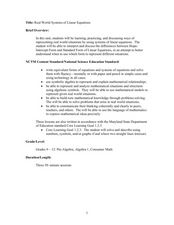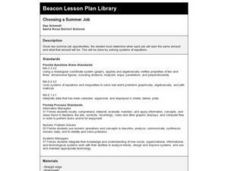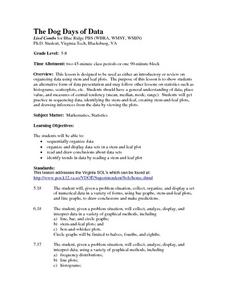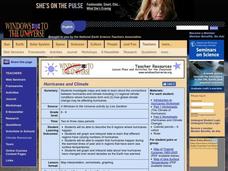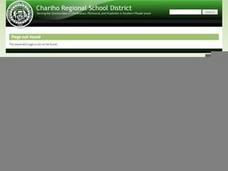Curated OER
Quadratic Equations and Parabolas
Learners graph and solve quadratic equations. In this functions instructional activity, students analyze a quadratic equation using three points on a curve to define the graph of a quadratic function. They find the vertex and intercepts...
Curated OER
Cockroach Slope
Students identify the slope of linear functions. In this slope lesson, students collect data and graph it. They write equations with no more than two variables and use technology to explain their data.
Curated OER
Jack and the Beanstalk Math
Students listen to Jack and the Beanstalk and determine what they think are the most common words. In this Jack and the Beanstalk instructional activity, students reread the story, count the words they chosen and graph those words....
Curated OER
Using Tables to Solve Linear Functions
Oh that intercept! Budding algebra masters solve linear equations from standard to intercept form. They identify the slope and y-intercept to help graph the lines, an then create coordinate pairs using a table of values. Great TI tips...
Curated OER
Exponential vs. Power
Pupils differentiate between exponential and power functions. They identify the base, exponent and properties of exponential functions. They also graph the functions using the TI calculator.
Curated OER
Circles and Angles
Students identify tangents, chords and secants. In this geometry lesson, students graph circles and identify angles created by secant lines, tangent lines and chords.
Curated OER
Betweenness and the Sum of Parts
High schoolers differentiate lines and angles using betweenness in this geometry lesson. They differentiate angles and lines using Cabri Jr. and analyze the data and make conjecture.
Curated OER
Angles and Transversals
Pupils explore the concept of angles and transversals. They construct parallel and non-parallel lines cut by a transversal using Cabri Jr. Learners then determine which angles are congruent and the relationship of angles when two lines...
Curated OER
Transforming Triangles
Sixth graders graph translations (slides) and reflections (flips) on a coordinate plane. They visualize and identify geometric shapes after applying transformations on a coordinate plane. Finally, 6th graders write a paragraph telling...
Curated OER
Altitude, Median, and Angle Bisector of a Triangle
Learners investigate the special properties of an altitude, a median, and an angle bisector and explore how these special segments divide the area of a triangle. The dynamic nature of Cabri Jr. allows pupils to form and verify conjectures.
Curated OER
Math/Technology: Height Measurement
Third graders, using technology tools, determine the total height of their classmates in both inches and centimeters. Once the measurements are taken, they enter the results in the Excel file. Once students have prepared a KidPix number...
EngageNY
The Inverse Relationship Between Logarithmic and Exponential Functions
Introducing inverse functions! The 20th installment of a 35-part lesson encourages scholars to learn the definition of inverse functions and how to find them. The lesson considers all types of functions, not just exponential and...
EngageNY
Vectors in the Coordinate Plane
Examine the meaning and purpose of vectors. Use the lesson to teach your classes how find the magnitude of a vector and what it represents graphically. Your pupils will also combine vectors to find a resultant vector and interpret its...
Curated OER
Slippery Slope
Students define patterns, relation and function. In this algebra lesson, students find the slope of a line and write equations of line. They model the slope using real life scenarios.
Curated OER
Real World Systems of Linear Equations
Students solve systems of equations with fluency. In this algebra lesson plan, students graph, use elimination and substitution to solve systems of equations. They identify the point of intersection using algebra.
Curated OER
Slope Calculation
Students compute the slope of a line based on the coordinates of two points on the line. In addition, they examine the relationship between the numerical value of slope and its properties on a graph.
Curated OER
Choosing a Summer Job
What did you do over your summer vacation. Young wage earners must compare summer job options, and determine when each job earn the same amount and what that amount be. This be done by creating, graphing, and solving systems of...
Curated OER
Introducing Linear Terminology
Ninth graders graph linear equations and inequalities in two variables and then, they write equations of lines and find and use the slope and y-intercept
of lines. They use linear equations to model real data and define to define the...
Curated OER
A Point of Intersection
Students factor and solve systems of equation. For this algebra lesson, students identify the point of intersection using substitution, elimination and graphing. They write an equation given a system and a graph.
Curated OER
Discovering the Linear Relationship between Celsius and Fahrenheit
Learners discover the linear relationship between degrees Farenheit and degrees Celsius. They manually compute the slope and y-intercept of the line passing through points. They convert Celsius to Fahrenheit degrees.
Curated OER
Comparing Positive Fractions, Mixed Numbers & Decimals
Seventh graders explore the concept of fractions, mixed numbers, and decimals. In this fractions, mixed numbers, and decimals lesson, 7th graders compare different forms of rational numbers on a number line. Students order rational...
Curated OER
The Dog Days of Data
Students practice an alternative form of data presentation. They practice sequencing data, identifying the stem-and-leaf, creating stem-and-leaf plots, and drawing inferences from the data by viewing the plots.
Curated OER
Hurricanes and Climate
Students investigate maps and data to learn about the connections between hurricanes and climate. In this exploratory lesson students describe and graph the 6 regions where hurricanes happen and discuss how hurricanes have changed over...
Curated OER
You Light Up My Life
Third graders participate in various experiments involving light. They demonstrate how light travels in a straight line until it strikes an object. Students show ways that light can be reflected, refracted, and absorbed.
